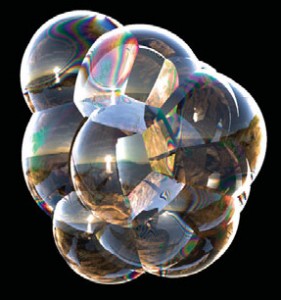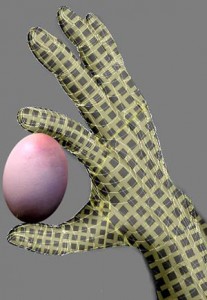I started the week with a posting where I highlighted a presentation about algae, biofuels, policy making, and politics (my Apr. 8, 2013 posting: Algae factories could produce nanocellulose for biofuels and more) and I’m going to end this week with another politics/policy posting, this time focusing on artemisinin and malaria.
Malaria is a serious, serious problem in many parts of the world as Brendan Borrell notes in his Apr. 4, 2013 article, The WHO vs. the Tea Doctor, about an herbal tea that contains artemisinin, for Slate.com,
Of all the illnesses that have afflicted humanity over millennia, few have left their mark quite like malaria, which infects 200 million people each year and kills at least 655,000, most of whom are children. [emphasis mine] Falciparum malaria—the most common type in sub-Saharan Africa—starts as a debilitating fever, which can progress in severe cases to convulsions, brain damage, and death. In this part of the world, it’s almost impossible to stay completely free of the parasites for long. Adults often display a low level of immunity, which makes each subsequent infection painful and unpleasant but usually not fatal.
As I’m about to contrast the information in Borrell’s article with the information in an Apr. 11, 2013 news release from the University of California Berkeley on EurekAlert, about the development of a synthetic artemisinin, I’m going to highlight their ‘agreement’ as the seriousness of the malaria problem,
… a lifesaver for the hundreds of millions of people in developing countries who each year contract malaria and more than 650,000, most of them children, who die of the disease. [emphasis mine]
Borrell sets the discussion for his take on the artemisinin situation with a little history (Note: Links have been removed),
The story of artemisinin demonstrates that even the best malaria drugs are worthless if they are not getting to the people who need them. In the late 1990s, African malaria parasites had become resistant to standard treatments such as chloroquine, and malaria deaths in Uganda doubled in a decade. By the early 2000s, there was a proven alternative: artemisinin combination therapies [ACTs]. Nevertheless, the Global Fund for AIDS, Tuberculosis, and Malaria repeatedly rejected countries’ requests for money for ACTs, funding failing treatments over ACTs at a rate of 10-to-1. In 2004, a group of fed-up scientists writing in the Lancet called these decisions “medical malpractice.” Today, although ACTs are heavily subsidized by the international aid community, local clinics frequently run out of stock, and Africans often end up with substandard, ineffective, and sometimes counterfeit medications.
Borrell goes on to recount the story of a Chinese plant, sweet wormwood ((Artemisia annua), which is the source for both a class of anti-malarial drugs and a tea (Note: A link has been removed),
It [sweet wormwood] can also be grown in wetter parts of Africa, and a year’s supply costs no more than a few dollars. Although the tea itself has traditionally been used in treatment, not prevention, in China, a randomized controlled trial on this farm showed that workers who drank it regularly reduced their risk of suffering from multiple episodes of malaria by one-third. For a group of people who were once waylaid by this mosquito-borne disease four or more times per year, the tea is a godsend.
According to the article, WHO (World Health Organization) and most malaria researchers are opposed to the tea’s use. Reasons given include the claim that herbal concoctions are more dangerous and less effective than pharmaceuticals and that use of the tea could lead to the malaria parasite developing resistance to the drugs.
There are two issues I have with the first claim about herbal concoctions. Having perused the Compendium of Pharmaceuticals (CPS), I can tell you the last I looked it was huge and listed thousands and thousands of drugs and their side effects (did you know that death is considered a side effect?). Fabrication in a laboratory does not equal safety any more that chopping something off a plant and brewing it as a tea equals safety. Personally, I don’t understand why they aren’t testing the tea, which is derived from sweet wormwood and successfully passed one randomized clinical trial, to see if the result can be repeated and also to test it against the drugs in human clinical trials.
As for the second claim that use of the tea could lead to the malaria parasite developing resistance to the drugs, isn’t that what happened to anti-malarial drugs in the late 1990s? Using chloroquine led to resistance against chloroquine. Following this claim to its logical end, we should never use any drug or herbal concoction as either might lead to resistance.
As for the tea’s successful clinical trial, the researcher experienced difficulty getting his study published (from the article; Note: A link has been removed),
While the workers are effusive about the tea, malaria experts have taken less kindly to it. When Ogwang [Patrick Ogwang of the Ugandan Ministry of Health] tried to publish the results in Malaria Journal, a reviewer largely praised the quality of the science but nixed publication out of concern that use of the tea could render ACTs ineffective. It’s a remarkably patronizing recommendation: that a scientific journal should keep the latest evidence out of the hands of Africans, lest they begin treating themselves. Marcel Hommel, editor in chief of the journal, defends the decision, saying, “It is the responsibility of an editor to avoid publishing papers that promote interventions which could potentially put patients at risk.” Ogwang eventually published his results in a less prestigious journal.
Borrell expresses reservations about herbal medicines/concoctions and he supports having the drugs for special cases but he also notes a study which suggests that a tea made from the plant might be more effective for adults and for less severe cases. From the article (Note: Links have been removed),
In the case of malaria, Anamed and others also argue that it makes sense to preserve stocks of conventional drugs for children and severe cases. One reason ACTs have been so expensive is the cost of isolating artemisinin, but there have long been indications that using a cruder, cheaper whole-plant extract could potentially be more effective and cheaper. In a study conducted in rats last year, University of Massachusetts researchers compared a single dose of pure artemisinin to dried whole leaves, and found that the whole plant was better at killing malaria parasites. And while millions have been spent bioengineering bacteria to crank out pure artemisinin on a budget, you still have to get it to the people who need it.
The resistance that the experts fear has been proved true, according to Borrell’s article, in areas where artemisinin drugs have been distributed and used with abandon.
Coincidentally or not, the University of California Berekeley announced a the development of semi-synthetic artemisinin in the Apr. 11, 2013 news release mentioned earlier,
Twelve years after a breakthrough discovery in his University of California, Berkeley, laboratory, professor of chemical engineering Jay Keasling is seeing his dream come true.
On April 11 [2013], the pharmaceutical company Sanofi will launch the large-scale production of a partially synthetic version of artemisinin, a chemical critical to making today’s front-line antimalaria drug, based on Keasling’s discovery.
The drug is the first triumph of the nascent field of synthetic biology and will be, Keasling hopes, a lifesaver ….
Keasling and colleagues at Amyris, a company he cofounded in 2003 to bring the lab-bench discovery to the marketplace, will publish in the April 25 issue of Nature the sequence of genes they introduced into yeast that allowed Sanofi to make the chemical precursor of artemisinin. The paper will be available online April 10.
“It is incredible,” said Keasling, who also serves as associate director for biosciences at Lawrence Berkeley National Laboratory and as CEO of the Joint Bioenergy Institute in Emeryville, Calif. “The time scale hasn’t been that long, it just seems like a long time. There were many places along the way where it could have failed.”
The yeast strain developed by Amyris based on Keasling’s initial research and now used by Sanofi produces a chemical precursor of artemisinin, a compound that until now has been extracted from the sweet wormwood plant, Artemsia annua. Artemisinin from either sweet wormwood or the engineered yeast is then turned into the active antimalarial drug , and typically mixed with another antimalarial drug in what is called arteminsinin combination therapy, or ACT.
Global demand for artemisinin has increased since 2005, when the World Health Organization identified ACTs as the most effective malaria treatment available. Sanofi said that it is committed to producing semisynthetic artemisinin using a no-profit, no-loss production model, which will help to maintain a low price for developing countries. Though the price of ACTs will vary from product to product, the new source for its key ingredient, in addition to the plant-derived supply, should lead to a stable cost and steady supply, Keasling said.
Unfortunately, no details about Sanofi’s no-profit, no-loss production model are offered. Perhaps a reader could ease my ignorance? I am interpreting this model to mean that while Sanofi won’t make money from the project, it does expect to recoup its costs (no-loss). (I most recently mentioned Sanofi, a French multinational, in an Apr. 9, 2013 posting about the winners of its 2013 competition for Canadian students.)
The backers of the research do provide some reasoning for this synthetic biology artemisinin project (from the news release),
“The production of semisynthetic artemisinin will help secure part of the world’s supply and maintain the cost of this raw material at acceptable levels for public health authorities around the world and ultimately benefit patients,” said Dr. Robert Sebbag, vice-president of Access to Medicines at Sanofi. “This is a pivotal milestone in the fight against malaria.” [emphasis mine]
I wonder what constitutes an ‘acceptable’ level of costs to public health authorities and, for that matter, to Sanofi. After all, I was under the impression after reading Borrell’s article that all one needed to do was to cultivate the plant and harvest it for materials to make tea. There was no mention of difficulties cultivating the plant in countries outside of China where it originated nor was there any mention that it was expensive to cultivate.
There are some fairly big names, in addition to Sanofi, involved in this synthetic biology project,
The success is due in large part to two grants totaling $53.3 million from the Bill & Melinda Gates Foundation to OneWorld Health, the drug development program for PATH, an international nonprofit organization aiming to transform global health through innovation. [emphasis mine] OneWorld Health shepherded the drug’s development out of Keasling’s UC Berkeley lab to Amyris for scale-up and then to pharmaceutical firm Sanofi, based in France, for production.
I am pointing out some interesting relationships with the intention of providing a view of a complex situation with many well-intentioned players, where lines of opposition have been drawn and the people most at risk seemingly forgotten. If the tea hasn’t caused resistance in over 1,500 years of use in China while the drugs have already done so on the Thai-Cambodian border as per Borrell’s article, why isn’t it being accepted and used? While some might point at corporate profit requirements (and I’m not discounting that motive regardless of what Sanofi’s company executives say), there are also issues of institutionalized opposition to any developments made outside of the medical establishment, and the fetishization of the laboratory environment where drugs are made pure in a pure environment while herbs come from the ‘dirty’ earth.
![E-whiskers are highly responsive tactile sensor networks made from carbon nanotubes and silver nanoparticles that resemble the whiskers of cats and other mammals. Courtesy: Berkeley Labs [downloaded from http://newscenter.lbl.gov/science-shorts/2014/01/20/e-whiskers/]](http://www.frogheart.ca/wp-content/uploads/2014/01/E-whiskersCat.jpg)
![An array of seven vertically placed e-whiskers was used for 3D mapping of the wind by Ali Javey and his group [ Kuniharu Takei, Zhibin Yu, Maxwell Zheng, Hiroki Ota and Toshitake Takahashi]. Courtesy: Berkeley Lab](http://www.frogheart.ca/wp-content/uploads/2014/01/E-whiskers.jpg)

